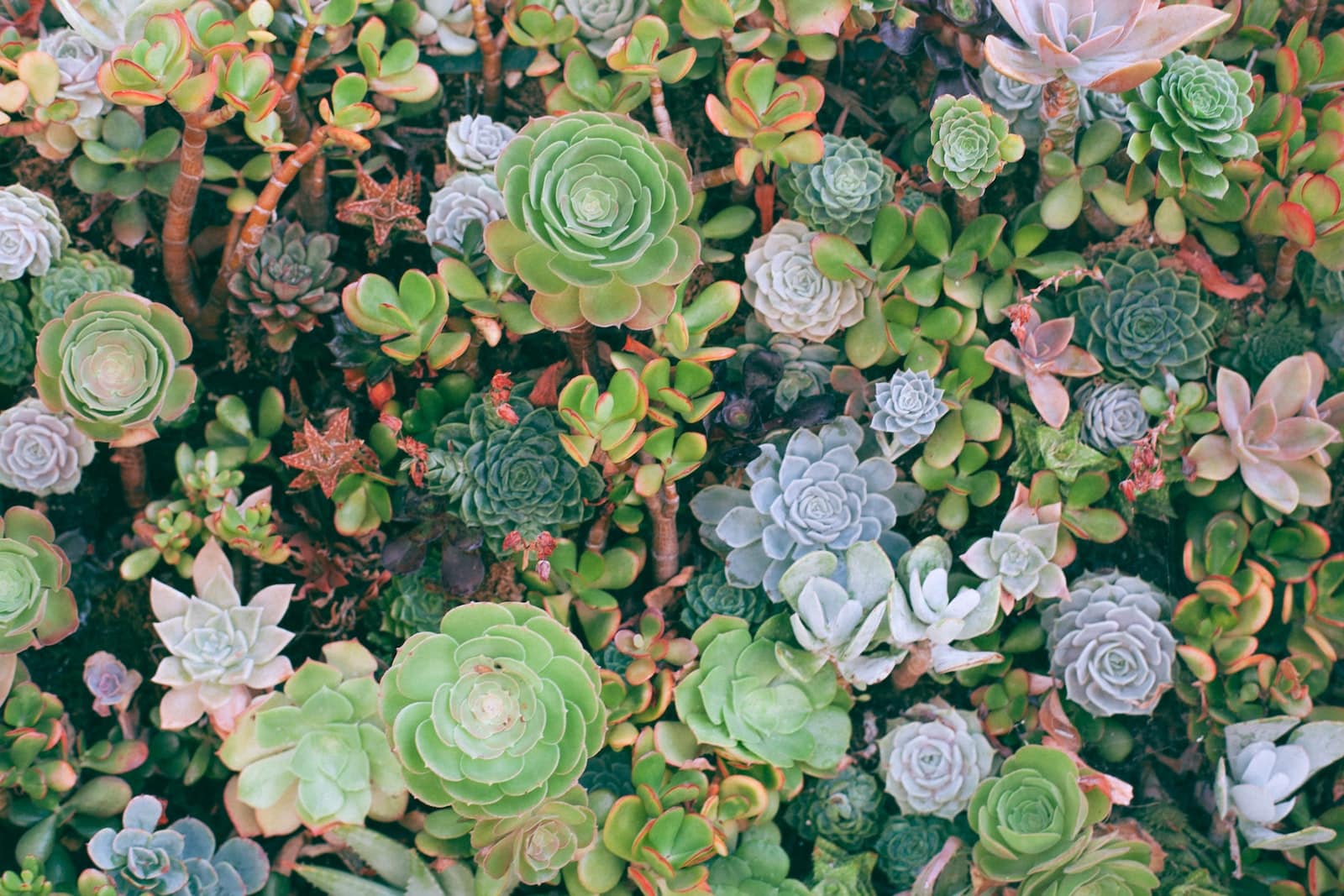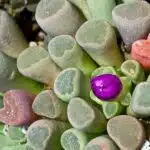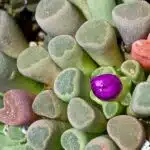Imagine your home’s interior as an artist’s canvas – one that you have the ability to fill with vibrant, living colors of nature. As if with a magical brush, you can paint your walls and windowsills with succulents in all shapes and sizes, from fuzzy Echeveria to delicate Sedum. With just a few practical tips and tricks, you can make these beautiful plants thrive indoors.
Like any masterpiece, growing succulents requires patience and care. And while they may be hardy plants, they still need attention to ensure they stay healthy and happy in their new home. But don’t worry — it’s not difficult! With the right information and techniques, even novice gardeners can make their succulents thrive indoors.
From soil choice to watering schedules, there are five simple steps that will ensure your succulents are well taken care of. By following these guidelines, you can keep your plants healthy while adding some stunning natural accents to your home décor. Keep reading for five practical tips on how to make your succulents thrive indoors!
1. Choose The Right Succulent Variety
We all have that one friend who can make a cactus sing and dance. Okay, maybe not literally, but still – you know the one I’m talking about. It’s like they have some kind of magical green thumb! Well, let me break it to you: growing succulents indoors isn’t as hard as it looks. All you need are some practical tips to get started.
First up, choosing the right succulent variety – it’s key! Different kinds of succulents prefer different levels of humidity and light, so do your research beforehand and pick varieties that suit your interior environment best. Then, make sure to provide adequate light for your new plant babies. Indirect bright light is usually ideal – no direct sunlight! Otherwise, they might get sunburned… yikes.
Finally, water wisely. Succulents don’t need much H2O; in fact, too much water can kill them quickly! To prevent this from happening, wait for the soil to completely dry out before watering again (maybe even stick your finger in there to double-check). That’s it! Follow these steps and you’ll be well on your way to becoming a master indoor gardener.
2. Provide Adequate Light
Light is the lifeblood for succulents. Without it, they will struggle to survive and thrive indoors. And like a ray of sunshine, providing adequate light can be just the thing to make your succulents flourish. Let’s explore how you can ensure your plants get enough light to stay healthy.
As much as we’d like our homes to be sun-drenched oases, that’s not always the case. So, you’ll need to give your succulents an extra boost of light if you want them to reach their full potential. If you don’t have a bright spot in your home, then invest in some artificial lighting such as LED grow lights or fluorescent bulbs. You’ll also want to rotate the pot every few days so that all sides of the plant get equal exposure – this will really help with growth and flowering!
It’s important to remember that too much light can be damaging for indoor succulents, so try not to place them near a window or anywhere where they may get scorched by direct sunlight. With the right balance of natural and artificial lighting, you’ll be on your way towards having happy and successful succulent plants in no time!
3. Water Your Succulents Properly
It’s estimated that up to 70% of succulents grown indoors don’t survive their first year due to inadequate watering. To ensure your succulents stay healthy, it’s important to water them properly. Here are four tips for how to do this:
Firstly, water only when the soil is completely dry. Succulents prefer an environment where they can dry out completely between each watering. If you’re unsure if the soil is dry, insert your finger into the top inch of the soil and feel it – if it feels damp, wait a few more days before watering.
Secondly, use lukewarm or room temperature water when you do decide to water. Cold water can shock your plant and cause its leaves to drop off.
Thirdly, use a watering can with a spout or a misting bottle – both will make sure your succulent gets enough moisture without over-watering it.
Finally, keep an eye on the leaves of your succulent – if they become soft or appear wilted then it’s likely that you’re either under-watering or over-watering them. The best way to correct this is by adjusting your watering schedule accordingly.
In order for your succulent to thrive indoors, it needs potting in the right soil as well as appropriate light and water levels.
4. Pot Your Succulents In The Right Soil
Potted plants, particularly succulents, need the right soil to thrive indoors. Proper potting is essential for any plant’s long-term success and it’s especially important for succulents as they tend to be quite sensitive to their environments. Following a few simple steps can help you nurture your succulents in the best possible way.
For starters, make sure you choose the right soil for your succulent. A well-draining soil is key to ensure that excess water doesn’t build up in the pot which could lead to root rot and other problems. Most succulent soils have added ingredients such as perlite or sand which allow for better drainage. You can also add these ingredients yourself if needed. Additionally, be sure to use a pot with plenty of drainage holes along the bottom so that water can easily flow out into saucers beneath the pots.
Successfully potted succulents will thrive indoors when given sufficient light and air circulation, plus just enough water and fertilizer. Watering correctly is very important — too little and your plant may become dehydrated; too much water means your plant may suffer from root rot or other serious damage due to overwatering. Fertilizing should also be done sparingly — once or twice a year should be more than enough for most species of succulents.
By paying careful attention to soil choice and watering habits, you can give your succulents all they need to flourish in an indoor setting. With proper care, you can enjoy these hardy plants throughout each season without worrying about their health or wellbeing!
5. Use Fertilizer Sparingly
When it comes to keeping your succulents thriving indoors, there is one key tip you should keep in mind: use fertilizer sparingly. But what does that mean exactly? What are the specifics of this essential step for caring for your succulents? Read on to find out.
The first thing you need to know is that fertilizer isn’t always necessary. In fact, overfertilization can be fatal for your succulents. If you do decide to use fertilizer, make sure you choose one specifically formulated for cacti and succulents. And when it comes time to fertilize, use only half the recommended dosage on the label and apply every other month during the growing season.
It’s also important to remember that too much of a good thing can have disastrous consequences – like burning your plants or encouraging too much growth at once! So take care when using fertilizer and pay close attention to how your plants respond. With these tips in mind, you’ll be well on your way to creating a happy home for your succulents!
6. Choose The Right Pot
Ahh, the beauty of succulents! With their unique shapes and vibrant colors, they can truly bring life to any living space. But when growing these delicate plants indoors, there are a few key tips to ensure they will thrive. One of them is choosing the right pot.
When selecting a pot for your succulent, it’s important to remember that drainage is key. Look for pots with drainage holes on the bottom and make sure to use well-draining soils such as cactus or succulent mix. This will help prevent root rot and ensure your plant receives enough water without becoming oversaturated. Additionally, if you’re using a planter without drainage holes, try adding a layer of pebbles or gravel to the bottom before placing in soil; this will allow excess water to seep out of the planter and into the gravel instead of sitting at the bottom of the pot and causing root rot.
Choosing a pot size also matters for your succulent’s health. Too large of a container can result in too much soil and moisture which can cause root damage from over-watering; meanwhile too small of a container won’t provide enough room for an established root system or allow proper air flow. Consider buying several smaller pots rather than one larger one so you can repot as needed to give your succulent adequate space as it grows.
By following these simple steps you can be sure your succulent is getting all it needs to grow strong and healthy – while still looking beautiful in its new home!
7. Allow For Proper Air Flow
The air flow of a succulent garden is like the wings of a butterfly, fluttering lightly and delicately as it moves through the breeze. Without proper air flow, the delicate petals of these plants would be unable to thrive in their indoor environment. Like a butterfly, succulents need room to spread their wings and breathe in order to survive.
To ensure that your succulents receive enough air flow, try using taller pots or containers with many holes for drainage. This will allow air to move freely around the plant’s roots and provide them with the oxygen they need to stay healthy. Additionally, make sure that you don’t overcrowd your succulents when planting them so they can get enough airflow from every direction.
When it comes to providing ample airflow for your succulents indoors, making sure they have adequate space is key. Doing this will help ensure that you have happy and healthy plants that can thrive in an indoor environment without any problems. With proper air circulation in place, you’ll be able to enjoy the beauty of your indoor garden for years to come. The temperature and humidity of your succulent’s environment are just as important for its health as allowing for proper air flow – let’s take a closer look at how we can control both of these elements next.
8. Control Temperature And Humidity
It’s important to control temperature and humidity levels when caring for succulents indoors. If the environment is too dry, the succulent will not be able to absorb enough moisture. On the other hand, if it’s too humid, it can cause root rot and other problems. You should aim to keep humidity between 30% and 50%. Additionally, you need to make sure that temperatures don’t drop below 50°F or exceed 80°F.
Having a thermostat can help you regulate temperature and humidity levels in your home. Additionally, you can use a hygrometer to monitor relative humidity levels in your home. If conditions are too humid, try using a dehumidifier or open up windows for ventilation. To keep temperatures warm in cold weather, use a space heater or place your succulent near a radiator.
Taking these steps will ensure that your succulent has the ideal environment for thriving indoors. With careful monitoring of temperature and humidity levels, plus regular care such as cleaning leaves regularly, you’ll be able to help your succulents stay healthy and vibrant for years to come.
9. Clean The Leaves Regularly
Keeping your succulents healthy requires regular maintenance, and cleaning the leaves is an important part of that. This simple practice helps keep debris from blocking the plant’s pores, allowing it to absorb nutrients and moisture more efficiently. Additionally, wiping down the leaves can help remove dust and pests, which can be detrimental to your succulents’ health.
To clean the leaves of your succulents, you’ll need a soft cloth or paper towel and some lukewarm water. Gently wipe off each leaf individually with the damp cloth or paper towel, being sure not to rub too hard so as to not damage them. Make sure all dirt and debris is removed from both sides of the leaf before moving on to the next one. Afterward, let the plant dry completely before placing it back in its pot.
By taking care to clean off your succulents’ leaves regularly, you can ensure that they’re absorbing as much light and nutrients as possible for healthy growth indoors. Of course, this isn’t the only step you’ll need to take: Next up is dealing with pests that may try to make their home on your beloved plants.
10. Deal With Pests
Dealing with pests can be an exasperating experience, but it doesn’t have to be! To keep your succulents around for the long haul, here are some tips to tackle pesky critters. Just like a knight slaying a dragon, you can take on these pests and win.
First off, prevention is key. Like an old adage states: ‘An ounce of prevention is worth a pound of cure.’ To prevent pest infestations in the first place:
• Monitor your plants regularly for signs of pests or disease
• Keep your plants away from other potentially infested sources (e.g., soil or other plants)
• Check for signs of pests when bringing new plants into the home
If you do spot any bugs on your succulents, don’t panic! There are ways to get rid of them naturally without using harsh chemicals. Here are some successful strategies that won’t harm your plant:
• Use neem oil as a natural insecticide
• Wipe down the leaves with rubbing alcohol
• Spray with diluted soap-water solution
Thanks to these simple solutions, you can keep those annoying bugs away and save your succulent from harm. Now that pest-control is under control, it’s time to turn our attention to the next step – rotating your succulents!
11. Rotate Your Succulents
Many succulent owners are unaware that it is important to rotate their succulents. Research shows that more than half of indoor succulent owners do not regularly rotate their plants. Rotating your succulents helps ensure that all sides of the plant receive adequate sunlight, which can help them thrive indoors.
Rotating your succulents should be done every two to three weeks. Make sure to turn them a quarter turn each time so they can soak up the light evenly from all angles. If you notice that one side of your succulent is growing much faster than the other, this could be a sign that it needs more light or sunlight on one particular side. You can also use a sun lamp to provide additional light if needed.
If you’re looking for an easy way to help your succulents flourish, rotating them regularly is an easy and effective solution. Not only will it help keep them healthy, but it will also make sure they look as beautiful as possible! With just a few minutes every couple of weeks, you’ll be amazed at how much healthier and vibrant your succulents become with regular rotation. Transitioning into the next step of trimming leaves and stems will further bring out the beauty in your interior-dwelling plants!
12. Trim Succulent Leaves And Stems
The sight of succulents can be mesmerizing. Their unique shapes and vibrant colors create a captivating scene in any indoor space. But if you want your succulents to thrive, it’s important to pay attention to their maintenance. Step 12: trim succulent leaves and stems.
Trimming your succulents is essential for their health. Leaves that are brown or yellow should be removed immediately as they can spread disease throughout the plant. Also, remove any dead or dying stems, as these can also spread disease and weaken the entire plant. By doing this regularly, you’ll ensure that your succulent remains healthy and continues to thrive indoors.
When trimming, use sharp pruning shears so that you don’t damage the plant’s stem or leaves unnecessarily. You should also take care not to leave too many cuts on the plant as this will make it more susceptible to infection. Trimmed pieces can then be propagated into new plants – a great way to replenish your collection!
13. Propagate Succulents
Propagating succulents is a great way to keep your collection growing and thriving. It’s an easy process that requires minimal supplies and effort, but yields big results. Here are four steps to propagate succulents:
First, choose a healthy leaf or stem from an established plant for propagation. Make sure the leaves are firm and plump, with no discoloration or mushy spots. Then, gently remove the leaf or stem you selected and place it on wax paper. Allow the wound to dry out and callous over for several days before attempting to replant it.
Second, create a mixture of potting soil, sand, and perlite in equal parts. This will provide adequate drainage for your propagated plants. Place the soil mix in a container with drainage holes at the bottom. Next, take your dried-out leaf or stem cutting and carefully plant it in the container about one inch deep. Water lightly until there is runoff coming out of the bottom of the pot, then let it sit for several weeks until you see new growth sprouting out of the ground.
Finally, move your propagated succulent into indirect sunlight and keep its soil slightly moist by watering every other day or when it feels dry to the touch. Within a few weeks you’ll have a beautiful new addition to your indoor garden!
14. Repot Succulents
Repotting succulents is a great way to ensure they get the nourishment and space they need to thrive indoors. The process is simple and straightforward, but it’s important to do it properly in order to maximize the benefits. First of all, you’ll need to decide if your succulent needs a bigger pot or not. If so, choose one with drainage holes in the bottom so that excess water can escape and prevent root rot. You’ll also need some soil mix specific for succulents and cacti, as well as some gravel to help with drainage.
Once you’ve got everything ready, it’s time to repot your succulent! Carefully remove it from its old pot and tease out any tangled roots. If needed, trim away any dead or damaged roots before placing the plant into its new pot. Make sure there are adequate drainage holes in the bottom, then fill up with soil mix until the plant is planted at the same height as before. Finally, add a layer of gravel over the soil mix for extra drainage protection before giving your plant plenty of water and sunshine.
With these simple steps taken care of, you can now enjoy your thriving succulents! With proper care and attention like this repotting process, they’ll be sure to thrive indoors for many years to come.
15. Enjoy Your Thriving Succulents
Many of us are daunted by the process of gardening indoors. We may worry about whether our succulents will actually thrive and how much effort it’ll take to keep them alive. But the truth is, with a few easy steps, you can enjoy your own thriving indoor garden!
For starters, repotting succulents is key. You want to make sure that they have room to grow, and this means changing out their soil once in a while. Make sure you use a potting mix that’s specifically created for succulents and cacti, so they get all the nutrients they need.
Once you’ve done that, you’ll be able to sit back and watch your succulents thrive! Make sure they’re getting plenty of sunlight, as well as watering when necessary. You can also fertilize them every few weeks or months if needed – just check on their labels for specific instructions.
TIP: If you’re ever unsure about how much water or sunlight your succulents need, take a look at their leaves! Succulent leaves will tell you a lot – if they’re shriveled up or wrinkled, that means they need more water; if their leaves are turning yellow or brown, that means too much sun exposure.
Frequently Asked Questions
How Often Should I Fertilize My Succulents?
The sun, symbolizing the life-giving energy these plants need, is an essential ingredient for any succulent’s success. However, in order to thrive indoors, fertilizer should also be added to the mix. The question of how often should one fertilize their succulents can be a tricky one.
Succulents are hardy plants and don’t require much maintenance so it’s important not to overdo it with the fertilizer. During their active growing season they should be fertilized every 4-6 weeks with a balanced liquid fertilizer diluted to half strength or less. Once summer ends and winter approaches, it’s time to take a break from the fertilizer until spring rolls around again.
It’s worth noting that there are certain types of succulents that won’t require any additional feeding at all and will do just fine without supplemental nutrients. When in doubt, err on the side of caution when setting your fertilizing schedule; too much can lead to overgrowth and nutrient deficiencies which can be damaging for your indoor succulents.
Can I Grow Succulents Outdoors In Colder Climates?
Have you ever wondered if it is possible to grow succulents outdoors in colder climates? Growing succulents outdoors in cold climates can be difficult but it’s not impossible. So, how do you make it work?
First of all, you need to choose the right type of succulent for your climate. Some varieties are hardier than others and will withstand lower temperatures better. You should also plan for extra protection from frost or snow, such as a cold frame or greenhouse. Additionally, take into account where you are planting your succulents: ideally, they should be placed in an area that gets some sun and a lot of air circulation.
Finally, it is important to keep your soil moist while avoiding overwatering. Succulents need regular water when they are actively growing during the warmer months but don’t require much during the cooler months when their growth slows down. Also, make sure that you fertilize your plants regularly with an organic fertilizer formulated for succulents. With these tips in mind, you can successfully grow succulents outdoors even in colder climates!
How Can I Tell If My Succulents Are Getting Too Much Or Too Little Light?
When growing succulents indoors, it’s important to ensure they’re getting the right amount of light. Too little light can cause the leaves to become elongated, while too much light can cause them to shrivel and turn brown. So, how can you tell if your succulents are getting enough light?
One way is by taking a look at their color. Succulents that aren’t getting enough light tend to have paler or yellowish hues and may lack robustness. On the other hand, those that are receiving too much light will have brown spots on their leaves and appear withered.
If you’re unsure about the amount of light your succulents are getting, it’s a good idea to move them around your home or office until they find an ideal spot. A windowsill or a corner near a window is usually a great place for succulents as long as the area isn’t exposed to direct sunlight for extended periods of time. Once you’ve found a suitable spot for your succulent friends, you can sit back and watch them thrive!
Is It Necessary To Repot My Succulents?
When it comes to succulents, there’s no denying their lush beauty and ease of care. But what about repotting them? Is it necessary? It’s an important question that we’ll answer here.
Allusion: Many of us have seen the movie “Fantastic Mr. Fox”, which follows a wily fox as he outsmarts a group of farmers. Similarly, when caring for succulents, you must be sly and clever in your approach.
Repotting succulents is not always necessary, but certain factors may warrant it. Here are some key points to consider:
- If the roots are overcrowded and pushing up against the sides of the pot, it might be time for a bigger container.
- If the succulent is wilting or losing its color despite ample sunlight and water, this could indicate poor drainage or soil compaction – both reasons to repot with fresh potting mix.
- Succulents can also benefit from seasonal repotting as they grow larger over time – just make sure not to disturb or damage their delicate roots!
The bottom line is that repotting isn’t always essential for successful indoor gardening; however, if you notice any signs of distress with your succulents, it may be worth considering a new home for them. In other words, use your best judgement and do whatever makes sense for you and your plants!
What Is The Best Way To Water My Succulents?
Watering succulents can be tricky. It’s like walking a tightrope – too little and the plant will wither away, but too much and it’ll drown in its own waterlogged soil. Knowing the best way to water your succulents is key to their thriving indoors.
When it comes to succulent care, most gardeners know that less is more. Succulents prefer infrequent yet generous watering sessions rather than frequent light sprinkles. Water your plants deeply and slowly; this ensures that the soil gets completely saturated so the roots can soak up all they need while avoiding soggy soil. At least once a week, or every two weeks during winter months, is plenty for most types of succulents.
A good way to check if you’re watering your plants enough is by feeling the soil with your fingertips or poking it with a chopstick – if you feel moisture when you insert it into the soil then you don’t need to water yet. Additionally, some succulent varieties do not need to be watered at all during winter months since they go dormant!
TIP: You can also add a layer of gravel at the bottom of each pot so excess water drains away from the roots quickly and efficiently, helping prevent root rot from overwatering!
Conclusion
Succulents can be a great addition to any indoor living space. With the right combination of light, water and fertilizer, you can have a thriving succulent garden for years to come. By following the five practical tips outlined in this article, you can ensure that your succulents will remain healthy and vibrant indoors no matter what the season or climate.
Caring for a succulent is much like tending to a small child – it requires love, patience and dedication. With proper attention, your succulents will reach their full potential with bright colors, lush leaves and robust stems. Like any good relationship, time spent nurturing your plants will bring rewards of beauty and joy.
By understanding the basic needs of your succulent plants, you can create an oasis of life in any room of your home or office. Take these five practical tips to heart and watch as your succulent garden grows and blooms with health and vitality.





























